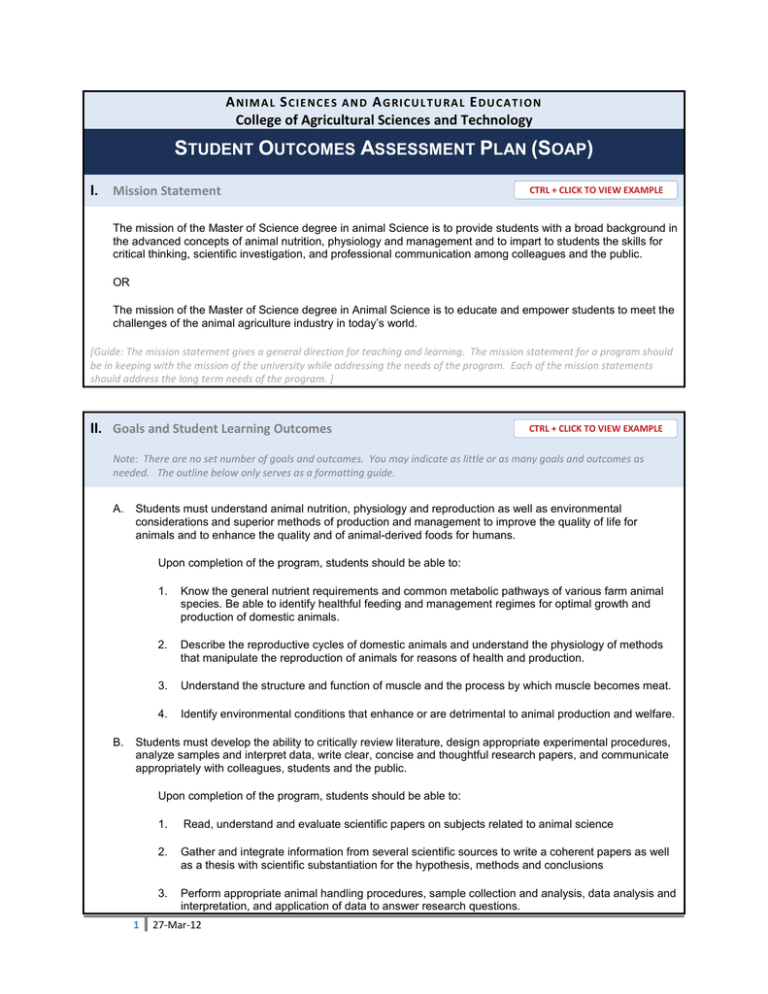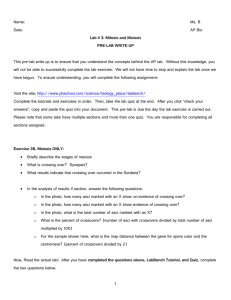S O A P
advertisement

A N I M A L S C IE N C E S A N D A G RIC U L TU RA L E D U C A T I ON College of Agricultural Sciences and Technology STUDENT OUTCOMES ASSESSMENT PLAN (SOAP) I. Mission Statement CTRL + CLICK TO VIEW EXAMPLE The mission of the Master of Science degree in animal Science is to provide students with a broad background in the advanced concepts of animal nutrition, physiology and management and to impart to students the skills for critical thinking, scientific investigation, and professional communication among colleagues and the public. OR The mission of the Master of Science degree in Animal Science is to educate and empower students to meet the challenges of the animal agriculture industry in today’s world. [Guide: The mission statement gives a general direction for teaching and learning. The mission statement for a program should be in keeping with the mission of the university while addressing the needs of the program. Each of the mission statements should address the long term needs of the program. ] II. Goals and Student Learning Outcomes CTRL + CLICK TO VIEW EXAMPLE Note: There are no set number of goals and outcomes. You may indicate as little or as many goals and outcomes as needed. The outline below only serves as a formatting guide. A. Students must understand animal nutrition, physiology and reproduction as well as environmental considerations and superior methods of production and management to improve the quality of life for animals and to enhance the quality and of animal-derived foods for humans. Upon completion of the program, students should be able to: B. 1. Know the general nutrient requirements and common metabolic pathways of various farm animal species. Be able to identify healthful feeding and management regimes for optimal growth and production of domestic animals. 2. Describe the reproductive cycles of domestic animals and understand the physiology of methods that manipulate the reproduction of animals for reasons of health and production. 3. Understand the structure and function of muscle and the process by which muscle becomes meat. 4. Identify environmental conditions that enhance or are detrimental to animal production and welfare. Students must develop the ability to critically review literature, design appropriate experimental procedures, analyze samples and interpret data, write clear, concise and thoughtful research papers, and communicate appropriately with colleagues, students and the public. Upon completion of the program, students should be able to: 1 1. Read, understand and evaluate scientific papers on subjects related to animal science 2. Gather and integrate information from several scientific sources to write a coherent papers as well as a thesis with scientific substantiation for the hypothesis, methods and conclusions 3. Perform appropriate animal handling procedures, sample collection and analysis, data analysis and interpretation, and application of data to answer research questions. 27-Mar-12 C. 4. Analyze and interpret data appropriately to answer scientific questions 5. Present information to colleagues and classmates on topics in animal science 6. Write with clarity and good organization of thought, demonstrating correct spelling and punctuation. Students should become empowered to advance their own careers, to contribute to the Animal Science profession, and to educate themselves beyond the completion of the degree program. Upon completion of the program, students should be able to: 1. Communicate, verbally and in writing, in a clear and understandable way, using correct scientific terminology to express their ideas and goals. 2. Interact with professionals at scientific and industry meetings or at job interviews. 3. Become contributing members of professional associations and the animal industry. [Guide: Goals are general statements supporting the mission but are specific to a discipline. These statements give specificity to a program and serve as a guide to long-term directions for student learning. The major distinction between goals and objectives is the non-behavioral nature of goals. Goals may contain student learning outcomes such as appreciate, understand, and value. These are all worthy aspirations but cannot be measured directly.] III. Curriculum Map (Matrix of Courses X Learning Outcomes) 2 27-Mar-12 CTRL + CLICK TO VIEW EXAMPLE CORE 200 201 220 229 A1 A2 ELECTIVES 241 242 246 247 R R 248 R A4 R B1 R B2 E B3 R B4 R R R R THESIS 299 R R R A3 Other electives R R R R R E E R E E B5 R R R R R R B6 E R R R R R R C1 E E R R R R R C2 R C3 E R E E E E R – Reinforced E – Emphasized (Concepts are introduced (I) in undergraduate curriculum) (Concepts are usually not completely mastered (M)) 200 – Agri 200, Biometrics in Agriculture 201 – Agri 201, Agricultural Laboratory Techniques 220 – Agri 220, Research Methodology and Communications 241 – Asci 241, Endocrine and Reproductive Physiology 242 – Asci 242, Environmental Physiology of Domestic Animals 246 – ASci 246, Ruminant Nutrition 247 – ASci 247, Concepts in Non-ruminant Nutrition 248 – ASci 248, Meat Science and Muscle Biology 299, - Asci 299, Thesis Other elective courses can be from other departments or upper division courses in animal science if appropriate to the student’s area of study and not taken during the undergraduate program. Many students take elective courses in Chemistry and Physiology. 3 27-Mar-12 IV. Assessment Methods A. B. CTRL + CLICK TO VIEW EXAMPLE Direct Measures (at least three) 1. Assessment of selected essay type questions in final exams of graduate level animal science courses (ASci 241, 242, 246, 247 and 248). Questions will be evaluated for correctness of factual information, ability to interpret and/or apply information to answer questions and presentation of answer in an organized, complete and grammatically correct way (draft rubric attached). 2. Assessment of presentations of scientific materials in Animal Science Seminar (ASci 229). Presentations will be evaluated for organization, content (relevancy and currency), quality of slides/media, quality of conclusion, voice quality and pace, and professionalism (draft rubric attached). 3. Assessment of theses. Theses will be evaluated in sections pertaining to Introduction and review of literature, materials and methods, hypothesis, results and discussion (draft rubric attached). 4. ARPAS exam – data will be kept regarding the success rate of students who voluntarily take the exam for acceptance into the American Registry of Professional Animal Scientists. More information about ARPAS can be seen at ARPAS.org. Indirect Measures (Alumni Survey is required) 4 27-Mar-12 1. Survey of graduates of program since 2003 to assess graduate’s perception of their experiences within the program to prepare them for success after graduation (draft survey attached). 2. Survey of employers of graduates of program since 2003 to assess employer’s perception of work related skills of employees/graduates and how these skills are associated with our master’s degree program (survey yet to be developed). [Guide: In contrast to indirect measures such as opinion surveys and instruments that gather self-reports and/or third-party reports of student knowledge, direct measures of student learning are generated when students are evaluated in their performance of a stated objective. To obtain a direct measure of student learning, systematically gather data across student performances using scores on standardized or locally prepared examinations or activities, or scoring rubrics for performances, projects, theses, etc. If you choose to base your assessment in part on culminating experiences or portfolios be explicit in explaining how the products of these activities will be analyzed.] V. Student Learning Outcomes X Assessment Methods Matrix Evaluation of exam questions X X X X X X A1 A2 A3 A4 B1 B2 B3 B4 B5 B6 C1 C2 C3 Evaluation of oral presentations X X Thesis evaluation ARPAS exam Alumni survey Employer survey X X X X X X X X X X X X X X X X X X X X X X X X CTRL + CLICK TO VIEW EXAMPLE X X X X X X X X X X X X [Guide: SOAPs should include a matrix that shows linkages between outcomes and the methods designed to measure performance on those outcomes.] VI. Timeline for Implementation of Assessment Methods and Summary Evaluations CTRL + CLICK TO VIEW EXAMPLE Year 2009 to 2010 In the fall semester of 2009, two courses, ASci 246 and 247 will have included, in the final exams, two essay questions regarding broad application of materials learned throughout the semester. The answer to these two questions in each of the two courses will be evaluated by rubric to assess the level of student learning of factual information, 5 27-Mar-12 of interpretation and application of learned information, and the presentation of the answer on the final exam. In the spring semester of 2010, all students will be evaluated on their final oral presentation in ASci 229, Animal Science seminar. Oral presentations will be evaluated for organization, content (relevancy and currency), quality of slides/media, quality of conclusion, voice quality and pace, and professionalism. Year 2010 to 2011 Alumni survey of graduates since 2005. Year 2011 to 2012 Thesis evaluation – Thesis submitted in the past three years will be evaluated according to the thesis rubric. Year 2012 to 2014 Employer survey and evaluation of ARPAS exam data. VII. Closing the Loop - Summary Evaluation, Curriculum Adjustment, and Reporting CTRL + CLICK TO VIEW EXAMPLE Enter Process for Closing the Loop Findings from assessment activities will be discussed at faculty meetings to make decisions about ways to improve the M.S. Animal Science degree program. [Guide: Closing the loop refers to using the findings for improvement of curricula, instruction or programs. This is the reason for doing assessment. Without it, the preceding steps are meaningless. How findings were used to draw conclusions and/or make change must be documented, although that documentation does not need to be extensive.] 6 27-Mar-12

